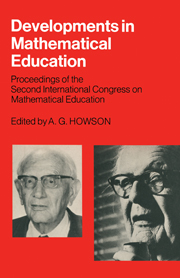 Developments in Mathematical Education
Developments in Mathematical Education from PART III - A SELECTION OF CONGRESS PAPERS
Intuition and comprehension in mathematical education
When the pupil is presented with a logical proof, is it necessary for him to have to add to this his own means of direct comprehension, that is to say, what is known as his intuition?
This is not a new problem. However, it has recently attracted much attention due to the increase in rigour of the mathematical proofs given in teaching situations. In my opinion, in order that these more axiomatised demonstrations do not stifle the mathematical reasoning process, it is absolutely essential to encourage the use of such intuitive support. This is the first problem that I should like to examine.
First, I consider that there are a number of distinctions that should be made: it is necessary to distinguish between what I call intuitions of adhesion and intuitions of anticipation. The intuition of adhesion expresses itself in the feeling of evidence about a certain fact. It is intuitively evident that the relation of equality is transitive, that from any point not on a straight line there can be only one perpendicular to that line, that there is always a natural number greater than a given number, etc. When I say that something is ‘intuitively evident’ I refer to the fact that the need for a mathematical proof is not felt in these cases (though, from the mathematical point of view, such a proof may be necessary).
To save this book to your Kindle, first ensure [email protected] is added to your Approved Personal Document E-mail List under your Personal Document Settings on the Manage Your Content and Devices page of your Amazon account. Then enter the ‘name’ part of your Kindle email address below. Find out more about saving to your Kindle.
Note you can select to save to either the @free.kindle.com or @kindle.com variations. ‘@free.kindle.com’ emails are free but can only be saved to your device when it is connected to wi-fi. ‘@kindle.com’ emails can be delivered even when you are not connected to wi-fi, but note that service fees apply.
Find out more about the Kindle Personal Document Service.
To save content items to your account, please confirm that you agree to abide by our usage policies. If this is the first time you use this feature, you will be asked to authorise Cambridge Core to connect with your account. Find out more about saving content to Dropbox.
To save content items to your account, please confirm that you agree to abide by our usage policies. If this is the first time you use this feature, you will be asked to authorise Cambridge Core to connect with your account. Find out more about saving content to Google Drive.